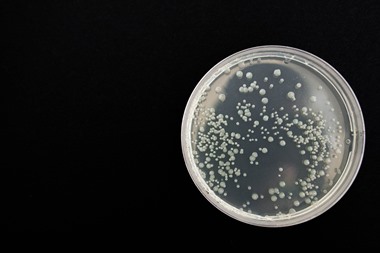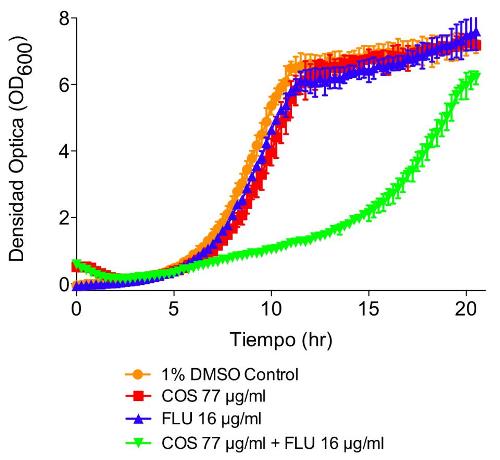Can we help you?
Contact us

Can we help you?
Contact us

Thank you for contacting us
Your form has been submitted successfully Our team will contact you again as soon as possible.
Whooppss...!! An error has occurred
Try sending later or write an email directly to areaempresas@ua.es

 PATENTED TECHNOLOGY
PATENTED TECHNOLOGY
INFO
SHEET
DOWNLOAD
EXECUTIVE
ABSTRACT
CONTACT DETAILS: Research Results Transfer Office-OTRI
University of Alicante
Tel.: +34 96 590 99 59
Email: areaempresas@ua.es
http://innoua.ua.es
The Plant Pathology research group of the University of Alicante has developed an antifungal composition based on the combined use of chitosan, or chitosan oligosaccharides together with inhibitors capable to modify gene expression of specific molecular targets to enhance sensitivity of eukaryotic cells to the effects of the chitosan or its oligosaccharides.
This composition is harmless to humans/animals and effectively inhibits growth of many fungal species, including pathogens. The main applications of this technology are: Pharmacology and Agriculture, but it is also applicable in other sectors.
The research group is looking for companies acquiring this invention for licensing agreement or technical cooperation.

Chitin is the second most abundant natural polymer after cellulose. It is an abundant natural polymer found, among others (e.g. in crustacean’s shells), making it an important by-product in fishing industry.
On the other hand, chitosan is an N-glucosamine polymer obtained by partial N-deacetylation of chitin.
Scientific studies have shown that chitosan exerts its antifungal action to several fungi through multiple mechanisms, including:
• Hyphal growth inhibition;
• Spore germination inhibition;
• Reduction of toxin production;
• Plasma membrane permeabilisation.
Acid hydrolysis or enzymatic cleavage of chitosan generates chitosan oligosaccharides (hereinafter, COS).
Biological activity of chitosan depends on its molecular weight, degree of deacetylation and pH. COS are water soluble (unlike chitosan) and have a smaller molecular size than chitosan. However, both chitosan and COS act by destabilizing and/or permeabilizing plasma membranes of bacteria, yeast and filamentous fungi.
Both COS and chitosan are non-toxic to mammals, and therefore, they are particularly interesting as antifungal agents in several applications.
Fungal pathogens have developed resistance to most currently antifungal used due to prolonged treatments in both pharmacological and phytosanitary applications. In view of the application of COS and chitosan as antifungal (alone or in combination with existing ones), it has been identified COS molecular targets. Their inhibition will improve the antifungal activity of COS and chitosan by enhancing the growth inhibition or death of fungal cells (yeast and filamentous fungi), their main target organisms.
Following extensive high-throughput chemogenomic assays (haploinsufficiency, homozygous and multicopy suppression profiling, and transcriptome analysis), ARL1 gene was identified as the main target of COS in yeast. ARL1 encodes a GTPase involved in plasma-membrane traffic, which could be a chitosan sensor. The present invention proposes the use of an inhibitor ARL1 gene to increase sensitivity of filamentous fungi and yeast cells to chitosan.
As ARL1 gene inhibitor is meant any molecule that binds to the gene, or its transcription factors, or any of their expression products, and inhibits or reduces the expression and / or activity of the factor that binds to and / or its intracellular signaling. This inhibitor is selected from the following list:
• RNA silencing;
• ARL1 specific- protein antibody (preferably monoclonal);
• GTP-GAMMA-S inhibitor;
• MLS000532223 GTPase inhibitor;
• AMF-26 GTPase inhibitor;
• Other antagonists.
This composition (chitosan or COS, and an inhibitor of ARL1 gene) is used to block growth of filamentous fungi and yeast through oxidative stress and cell death.
The fungi referred to the present invention include, but are not limited to the following list:
• Candida albicans;
• Candida glabrata;
• Botrytis cinerea;
• Fusarium oxysporum;
• Aspergillus fumigatus;
• Cryptococcus neoformans;
• Saccharomyces cerevisiae;
• Zygosaccharomyces bailii;
• Trichosporon spp.;
• Malassezia spp.;
• Scedosporium spp.;
• Any of fungi described as sensitive to chitosan.
The present composition relates to its use as antifungal, both to inhibit the growth of the fungus (fungistatic action) and to cause fungus death (fungicide action).
This invention also relates to the use of the composition in combination with at least one of the currently used antifungal compounds selected, among others, from the following list:
• Amphotericin B;
• Terbinafine;
• Fluconazole;
• Fluoropyrimidine analogs;
• Echinocandin analogues.
This composition (chitosan or COS, and an inhibitor ARL1 gene) can be used for pharmaceutical purposes in therapeutically effective amounts to prevent or to treat fungal infections, without causing adverse effects.
This pharmaceutical composition can be prepared in solid form (tablets, pills, capsules, granules, etc.) or liquid (solutions, suspensions or emulsions) composition of administration: parenteral, intraperitoneal, intravenous, intradermal, epidural, intraspinal, intrastromal, intraarticular, intrasynovial, intrathecal, intralesional, intraarterial, intracardiac, intramuscular, intranasal, intracranial, subcutaneous, intraorbital, intracapsular, topical, by transdermal patches, vaginally, rectally, by administering a suppository, percutaneous, nasal spray, surgical implant, internal surgical paint infusion pump and catheter, etc.
Also it can be as sustained release formulations (e.g., nanoparticles, liposomes, nanospheres, polymeric materials in biodegradable or non-biodegradable implants, or in biodegradable microparticles, etc.). This preparation can be used separately, sequentially or simultaneously.


These figures show the synergistic inhibitory effect of COS on yeast cell growth (OD600) when it is used in combination with an antifungal compound, in this case, fluconazole (FLU).
This technology aims to help controlling resistant strains of important filamentous fungi and yeast fungi (e.g. Candida spp.) originated after prolonged treatment with currently used antifungals.
The present invention provides for these purposes:
a) The use of novel antifungals (COS and chitosan).
b) The combined use (synergical) with existing antifungals (e.g. fluconazole) to reduce their doses.
c) The use of COS and chitosan (alone or in combination with existing synergical antifungals) with an inhibitor of ARL1 gene to increase the sensitivity of fungi (including yeast) or their chitosan oligosaccharides (COS).
Several experiments carried out have shown the significant synergistic effect of the combination object of the present invention (chitosan or COS, and an inhibitor of ARL1 gene or a currently used antifungal such as fluconazole) in inhibiting growth of filamentous fungi and yeast.
Chitosan and COS are non-toxic for mammals, and therefore, they have a particular interest to use them as antifungal agents in some applications.
The research group has conducted some tests on laboratory scale where successfully proven the effectiveness of this novel composition for inhibiting growth of filamentous fungi and yeast.
Industrial scaling of the present technology is simple and economically viable compared to the benefits of this invention in different fields of application.
This composition can be used as antifungal in various applications:
• Pharmaceutical: medicinal use (drugs).
• Human use or veterinary treatment and/or prevention of fungal infections by pathogenic fungi, such as Candida spp., Botrytis cinerea, Fusarium oxysporum, Aspergillus fumigatus, Cryptococcus spp., Saccharomyces cerevisiae, Zygosaccharomyces bailii , Trichosporon spp., Malassezia spp., Scedosporium spp., etc.
• In agriculture (phytosanitary treatments, preferably in infections caused by Botrytis cinerea and Fusarium oxysporum), but also in other pathogens in pre- and post-harvest plant diseases.
• In the food industry (for example, to coat foods in order to avoid microbial contamination).
• In the textile industry.
• As detergent (for cleaning different surfaces).
The research group is looking for companies interested in acquiring this technology for commercial exploitation through licensing agreements or technical cooperation.
This technology is protected by the following patent applications:
• Application number: P201230823
• Application date: 30/05/2012
Biology
Molecular Biology and Biotechnology
Footwear and Textile
Pharmacology, Cosmetics and Ophthalmology
Medicine and Health
Carretera San Vicente del Raspeig s/n - 03690 San Vicente del Raspeig - Alicante
Tel.: (+34) 965 90 9959




